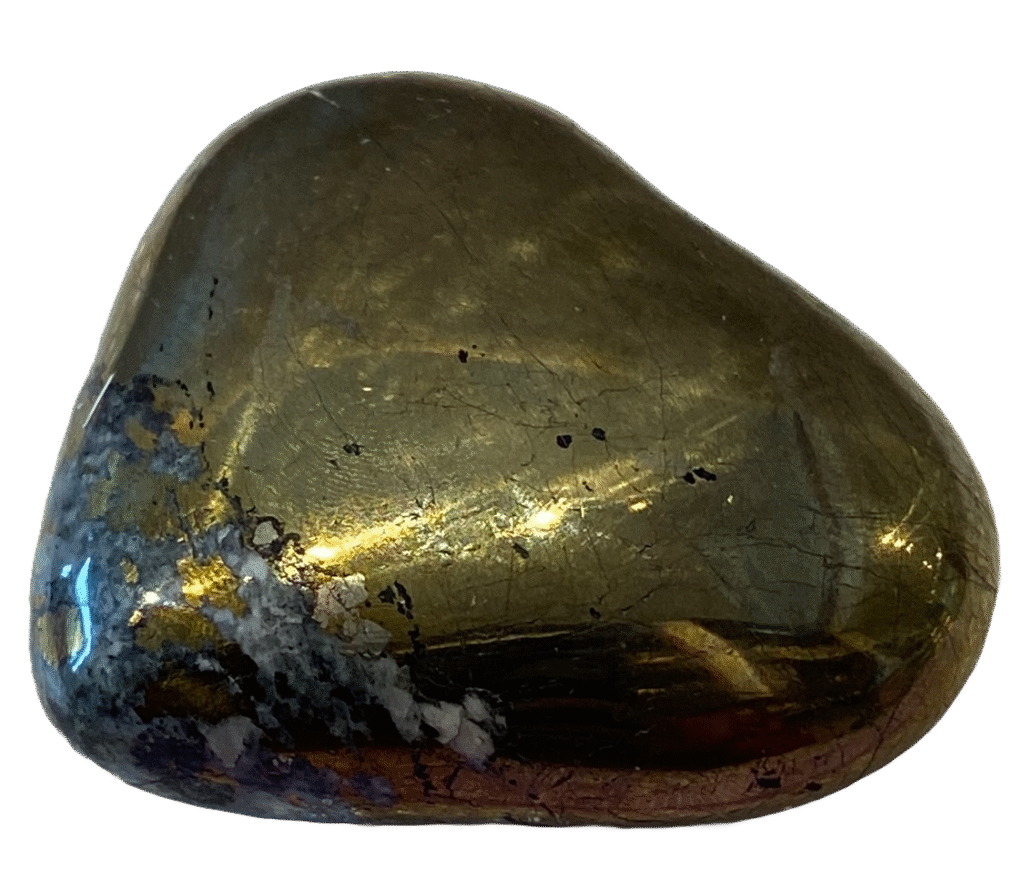
Chalcopyrite derives its name from the Greek words chalkos (meaning copper) and pyrites (meaning fire stone). Historically, it has been referred to as Fool’s Gold, often mistaken for gold due to its shimmering, brassy-yellow surface. Some metaphysical practitioners call it the Stone of Mysticism, attributing its properties to deep transformation and heightened intuition.
Composition, Physical Characteristics, and Varieties
Chalcopyrite is a copper iron sulfide mineral (CuFeS₂) and ranks 3.5–4 on the Mohs hardness scale. Its metallic luster, often displaying iridescent hues of gold, blue, green, and purple, makes it visually striking. Chalcopyrite tarnishes naturally, forming a colourful patina known as Peacock Ore—though true Peacock Ore refers to Bornite, another copper-based mineral.
Varieties include:
- Classic Chalcopyrite – golden-brass colour, commonly mistaken for gold.
- Iridescent Chalcopyrite – displays a rainbow-like tarnished surface.
- Massive Chalcopyrite – found in large, uncrystallised formations within ore deposits.
Geographical Locations Where It Is Found
Chalcopyrite is abundant worldwide, primarily mined in Mexico, Peru, Canada, the United States, Australia, and Russia. Some of the largest deposits occur within copper-rich areas, where it serves as a major copper ore.
Archaeological and Significant Finds with Historical and Current Usage
Ancient civilisations, including the Romans and Greeks, used Chalcopyrite as a primary copper source for tools and jewellery. In China, copper extracted from Chalcopyrite contributed to intricate bronze artifacts. Today, it remains one of the most important copper-bearing minerals used in industrial applications, while also gaining popularity in spiritual circles.
Interesting Facts
- Chalcopyrite is the most abundant copper-bearing mineral, crucial for modern copper production.
- Its tarnished surface can resemble Peacock Ore, though they are distinct minerals.
- Some miners historically mistook it for gold, leading to its nickname “Fool’s Gold.”
Folklore, Superstition, Legends, and Tales
For centuries, mystics and seekers have linked Chalcopyrite to transformation and hidden knowledge. Some saw it as a vessel of Earth’s secrets, offering profound insight. In ancient alchemy, its golden sheen symbolised spiritual enlightenment, guiding individuals toward wisdom and personal growth.
Mystical Healing Properties, Astrology, and Zodiac Associations
Chalcopyrite enhances intuition, manifestation, and spiritual awakening. Practitioners use it to clear mental blocks and strengthen their connection to higher consciousness. Astrologically, it aligns with Capricorn, Sagittarius, and Aries, providing:
- Capricorn – grounding energy and manifestation support.
- Sagittarius – spiritual exploration and clarity.
- Aries – motivation and fiery determination.
Chakra System Connections
Chalcopyrite works primarily with the Third Eye Chakra, sharpening intuition and insight. It also resonates with the Solar Plexus Chakra, promoting confidence and personal power.
Use as a Birthstone and for a Wedding Anniversary
While not a traditional birthstone, Chalcopyrite is a suitable alternative for Sagittarius and Capricorn birthdays due to its grounding and transformative energies. It also makes a meaningful gift for a 7th wedding anniversary, symbolising resilience and renewal.
Crystals That Work Well with Chalcopyrite and Those to Avoid
- Best Pairings:
- Amethyst – enhances spiritual clarity and insight.
- Tiger’s Eye – strengthens confidence and decision-making.
- Clear Quartz – amplifies manifestation energy.
- Crystals to Avoid:
- Black Obsidian – its intense grounding may overpower Chalcopyrite’s energetic flow.
- Blue Lace Agate – its gentle calming nature might contrast with Chalcopyrite’s dynamic properties.
